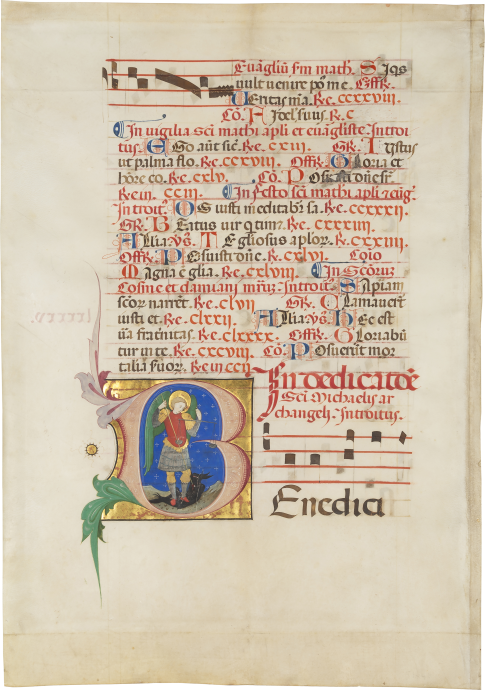Saint Michael Weigher of Souls Third Bessarion Master



Third Bessarion Master (active Lombardy third quarter of 15th century)
, Ferrara, Bologna, 1450–1460

Third Bessarion Master (active Lombardy third quarter of 15th century)
Description
This illuminated initial of Saint Michael comes from one of the most important Graduals produced in northern Italy in the mid-fifteenth century and was painted by the so-called “Third Bessarion Master” named for a famous commission of Choir Books originating from the Greek Cardinal Bessarion (c. 1399/1408–1472). Inhabiting an initial ‘B’ that forms the incipit to the Feast of Saint Michael, (“Benedicte domine…”), the archangel dangles a pair of scales in his right hand over a dragon, representing Satan, who he pins to the ground with a spear brandished in his left hand. The pink initial is set against a gold ground, with acanthus leaves sprouting into the margins.
The leaf (originally folio 95 of the Gradual) derives from the fourth of a fourteen-volume series of Choir Books commission by Bessarion for the Franciscan convent of Saint Anthony of Padua in Constantinople. One of the most important churchmen of the fifteenth century and papal legate in Bologna (1450–1455), Bessarion made a gift comprised of four gradual volumes, nine antiphonal volumes and a hymnal. While three of the Gradual volumes, namely those of the Proprium Tempore, have been preserved and are in the Biblioteca Malatestiana in Cesena (MS Bessario 1, 2, and 5), the fourth Gradual volume with the Proprium Sanctorum from which the present leaf originated was dismembered during Napoleonic times and the individual pages sold. Ten of them have survived, according to the current state of research, including the leaf offered here (Palladino 2003). The nine-volume Antiphonal series also suffered the same fate and half of the volumes have only survived in individual fragments.
The work for the illumination of this Choir Book series probably began around 1452 or shortly before. Two volumes (Cesena, Biblioteca Malatestiana, MS. Bess. 5, [1452] and MS. Bess 6 [1455]) are dated, but the illumination of the choir books must have extended over a longer period of time. The entire project was entrusted to a celebrated team of illuminators made up of several Lombard and Emilian artists, including the Third Bessarion Master, responsible for the present leaf, as well as the Second Master of Antifonario M from the San Giorgio Maggiore in Venice, the Master of the Breviario Francescano from Milan, and Francesco de Russi, a well-known miniaturist of the humanist Renaissance who also contributed to the famous Borso Bible in 1455–1460. As the frontispiece of several Bessarion volumes (Venice, Fondazione Giorgio Cini, 22124; Milan, Private Collection 72) bares the coat of arms of Borso d’Este’s as well as of Bessarion, it can be assumed that Borso d’Este supported the Greek cardinal at some point in this project, possibly when Bessarion left Bologna after 1455 and turned to various political missions.
Due to the Turkish wars and the fall of Constantinople (1453) the volumes never reached the Franciscan convent there and were instead entrusted to the Franciscan Observants at Santa Maria Annunziata dell ‘Osservanza in Cesena. Bessarion, who was in Vienna on a political mission in 1460—and still hoped to win back Constantinople despite fading hopes—probably decided shortly after 1460, in view of this political situation, to donate the choir book series to the Observant convent, founded by Violante Malatesta.
The Third Bessarion Master was a Lombard illuminator, named after his collaboration in the Bessarion project (Canova 1977). He was certainly one of the leading forces within this choir book series and his hand can be found in the earliest volumes. He developed his art rapidly during this project. While his first collaborations with his Lombard colleague, the Master of the Breviario Francescano, show him to be a rather unconfident and somewhat indistinctive illuminator, the artist developed under the impression of the more refined art of Franco de Russi and created illumination of the greatest sophistication. The present miniature depicting Saint Michael finds the artist at the height of his powers, displaying finely drawn, somewhat pale faces which bestow his figures with ethereality and psychological complexity, also seen in sister leaves from the series such as the Feast of All Saints from a leaf in the Oberlin Museum of Art (fig. 1). While only ten leaves from this gradual are presently known, these miniatures still constitute some of the finest specimens of northern Italian book illumination around the middle of the fifteenth century.
Literature
Bollati, Milvia. Arte in Lombardia tra Gotico e Rinascimento, Milan, 1988, p. 146.
Palladino, Pia. Treasures of a Lost Art, Italian Manuscripts of the Middle Ages and Renaissance, exhibition catalogue, Cleveland Museum of Art, San Francisco Museum of Fine Arts, New York, Metropolitan Museum, February 23, 2003–January 2, 2004, New Haven/London, 2003, pp. 80–83.
Canova, Giordana Mariani. “Una illustre serie liturgica ricostruita: I corali del Bessarione già all’Annunziata di Cesena,” Saggi e memorie di storia dell’arte 11 (1977), pp. 7-20.
Freuler, Gaudenz. Italian Miniatures from the Twelfth to the Sixteenth Centuries, Milan, 2013, pp. 672–79.


